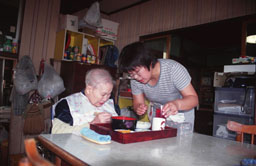 |
 Up until World War II, the typical Japanese household consisted of three generations-grandparents, parents, and children-all living together. After the war, though, as Japan became more industrialized, many young people moved to areas near the many new factories, and the nuclear family (parents and their children) rapidly became the typical model. More young couples chose to live apart from their parents, and the number of households where an old couple lived alone grew quickly.
Up until World War II, the typical Japanese household consisted of three generations-grandparents, parents, and children-all living together. After the war, though, as Japan became more industrialized, many young people moved to areas near the many new factories, and the nuclear family (parents and their children) rapidly became the typical model. More young couples chose to live apart from their parents, and the number of households where an old couple lived alone grew quickly.
From 1920 to 1955, the average size of a Japanese household remained around the level of five people. In 1953, almost 40% of all Japanese households had six or more people in them. This number was high because people had many children and because three generations of a family often lived in a single home. After 1955, however, the average size of a household dropped quickly; by 1995 it was only 2.84 people. In the past, very few people lived alone: Only 5.3% of all households in 1960 were one-person homes. By 1997 because of the large number of people marrying late, or not at all, and the many elderly people living alone that percentage had risen as high as 23.9%!
In 1997 there were about 5 million households-around 10% of the total in Japan-where three generations, including grandparents, lived together as a family. But this number is gradually shrinking. The number of households where all members are aged 60 or over, on the other hand, is on the rise. In 1970 there were around a million households consisting of just a couple or single person; by 1996 that number had reached over 6 million. In particular, the number of married couples and women living alone aged 60 or over grew by quite a bit.
Photo: Some senior citizens receive nursing care in their own homes. (PANA)
|